DEEP DIVE: The absurdly deep politics of this Transformers cartoon.
Colonialism, revolution, martyrdom, and merchandising.
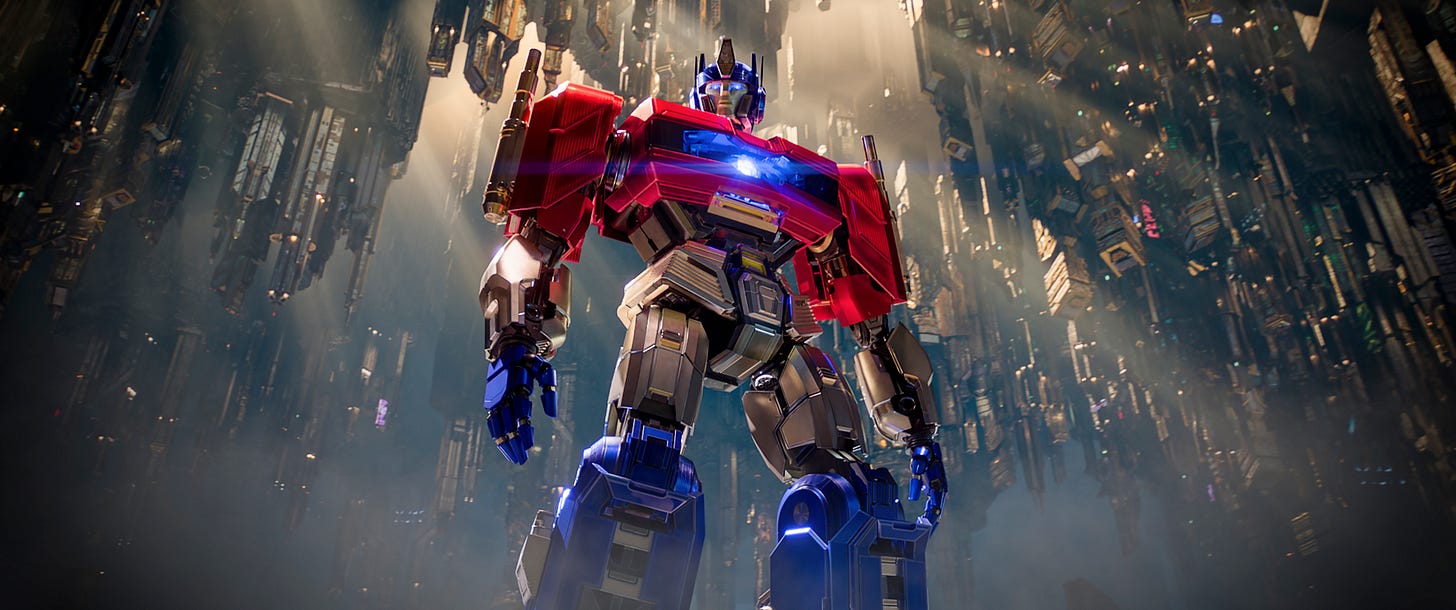
About six months ago, Paramount released a film which had a much greater political consciousness than typical for Hollywood. I connected with this film, because it had incredibly nuanced themes, yet managed to keep those themes accessible to a casual audience who might not consider themselves “political” in any fashion.
It wove a deep, complex narrative around the relationship between two slaves, condemned to a life in the mines, whose friendship is forged by their fight to survive a brutal and oppressive regime, only to be tragically split apart by their incompatible visions for what the revolution should bring.
Also, it’s an animated cartoon about toy robots for children. And Hasbro would like you to buy as many toys as you can.
Initially, I didn’t pay much attention to the trailers for Transformers One; the marketing team at Paramount significantly downplayed the serious tone of the film’s plot. From the impression they gave, it looked like it wouldn’t be particularly compelling…but then my friends started insisting I had to see it.
Firstly, I was told that it was better than any of the Michael Bay Transformers films, and I laughed because those were…not well reputed, to say the least. This would be setting the bar deep below the surface of the Earth.
But then someone told me that this movie was the best Transformers story ever made, in any medium. And as a casual fan of the franchise, having seen a few different entries (such as Beast Wars, proudly made in Vancouver, Canada), that was enough to pique my interest, at least a little.
Let’s All Go To The Lobby!

Admittedly, I was in a receptive state of mind to go see this movie. I have a monthly subscription to the theatre for discounted tickets each month, so I’ve been seeing a lot more movies in the theatre before they come out on Blu-ray.
I’m a firm believer that even with a nice home theatre, which I do have, going to an actual cinema will always be better. Comedies are better when other people are laughing with you. Just don’t use your phone, or I’ll commit war crimes.
I went to the Cineplex downtown in Toronto at Yonge and Dundas, a former AMC megaplex from the era when Canada still had competition in the movie theatre industry. Empire Theatres is gone, AMC is gone, Landmark and Cineplex try to avoid overlapping, so Canadian cinema fans are in oligopoly hell. But I digress.
The Cineplex-née-AMC at Yonge and Dundas was made for a bygone era, when going to the movie theatre was so popular that you could justify twenty-five screens in a single venue.
Hence, beyond a multiplex, it was a megaplex. I had to ride five escalators up through this multi-level complex to get myself to the tiny shoebox auditorium. In this fashion, it resembles its former AMC sibling, the AMC Empire 25 that stands just off Times Square.
Yet despite the film having been out for several weeks, despite box office reports being poor, and despite being in one of the lower-quality auditoriums in the megaplex, I walked into the room…and the theatre was completely packed.
I brushed this off as other people casually deciding to watch for the same reason I did, adults with disposable income and childhood nostalgia. It was in the evening, late in the week, and from what I saw buying my tickets, it was the only showtime with people attending.
But then the film began, and the audience was instantly taken by the quality of the writing, the acting, the animation, and the score. I understood instantly how marketing failed this film, and how word-of-mouth was the best hope to save it.
And yet it didn’t immediately settle in for me just how deep the political themes were, or how organically they were interwoven into the story and the character dynamics. But upon viewing the film a second time, many themes suddenly clicked, and I was astounded at how much the production team crammed in.
Analyzing and Spoiling the Plot
If you haven’t watched the movie, go watch it before you read this fountain of spoilers. If you’re not interested in watching, fine, but I warned you.
Act One: The Regime
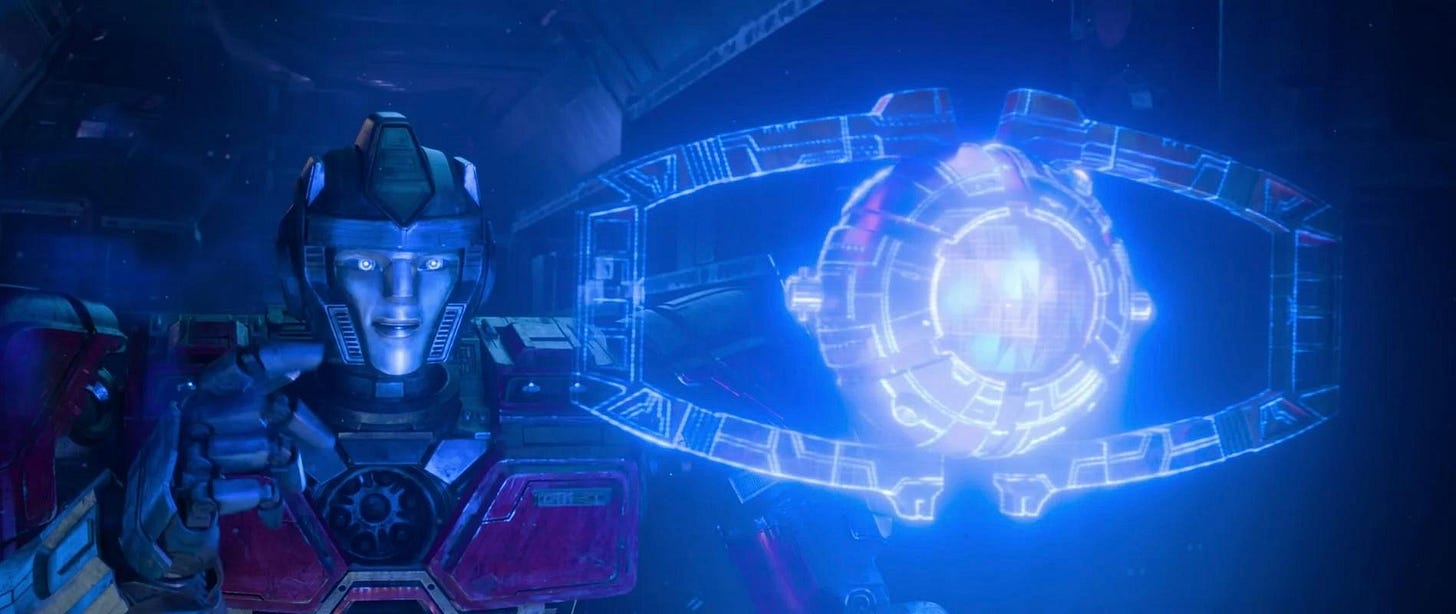
At the dawn of time, there was our gracious and powerful creator, Primus.
The film begins with Orion Pax (Chris Hemsworth) sneaking into a historical records vault, to learn something he already knows.
In the beginning, the creator god Primus sacrificed his form to save the universe, transforming his body into the planet Cybertron. From within his own planetary core, Primus birthed the first Transformers into existence, the Thirteen Primes.
Primus bestowed the Matrix of Leadership upon their leader, Zeta Prime, enabling Energon to flow throughout the planet. Cybertron transforms into a flourishing world, teeming with life and wonder. But one day, tragedy strikes, and the Matrix is lost. Without the Matrix, the Energon ceases to flow, and life on Cybertron withers.
For those of you whose eyes are starting to glaze over: this is the Transformers’ creation myth. This is the shared culture and history that guides the people of Cybertron…but we as an audience will soon learn that this history has been distorted.
Indeed, we learn it immediately. Orion Pax notes with frustration that this is the point where every historical record ends; this is true for both the public histories, and even these restricted records held back for only the bourgeois class.
Orion Pax, like his friend D-16 (Brian Tyree Henry), is a miner. They are “transformers”, but they do not have the physical cog in their chest that allows one to transform. It is this distinction between the cogless miners and the transforming ruling class that defines Cybertronian society, creating a caste system where the circumstances of your birth may force you into slavery.
While the upper classes of Cybertron gorge themselves on Energon at exclusive gatherings in palatial estates, the cogless miners toil in dangerous and lethal conditions, forced to physically extract Energon from within the planet, from within the resisting and unconsenting corpse of their god, now that Primus no longer wills it to flow.
Orion Pax is one of the few miners to even have a name; his best friend D-16, and the later-encountered B-127 (Keegan-Michael Key), many solely have a number, while the bourgeois reserve identity itself as one of their privileges.
Miners without numbers, such as Jazz (Evan Michael Lee) and Arcee (Jinny Chung), have likely given themselves their names as a means of resisting this depersonalization. D-16, on the other hand, has thrown himself into his identity, “following protocol”.

The one extravagance he allows himself is his idealization of Megatronus Prime, the strongest of the Primes; if a robot could blush, D-16 would have done so when Orion Pax gifted him a Megatronus sticker to wear on his shoulder.
Elita-1 (Scarlett Johansson), like Orion Pax and D-16, is also cogless and unable to transform. However, because she has been given a position as a “supervisor”, she has a name representing her “elite” status. Yet even she has still reduced herself to the mere status of a number, rather than a person.
It is Orion Pax, who chooses a name for himself, that is carving an individual path through this rigid and inflexible society. When one of the mine shafts caves in, Orion Pax acts rapidly to save Jazz’s life; this places him at odds with Elita-1, who is demoted to waste management after being blamed for the incident.
Ironically, his desire to prove useful to society, and prove that he can do more for society than the role he’s been assigned, is what exposes the rotten underpinnings of Sentinel Prime’s regime.
In the fifty years since the Primes were slaughtered in the war with the Quintessons, Sentinel Prime (Jon Hamm), the last survivor of their number, has “defended” the people of Cybertron, overseeing the post-war society.
He frequently leaves Cybertron in search of the Matrix of Leadership, and as a result the daily governance of Cybertron is instead left to those bourgeois functionaries that he has appointed to serve at his pleasure.
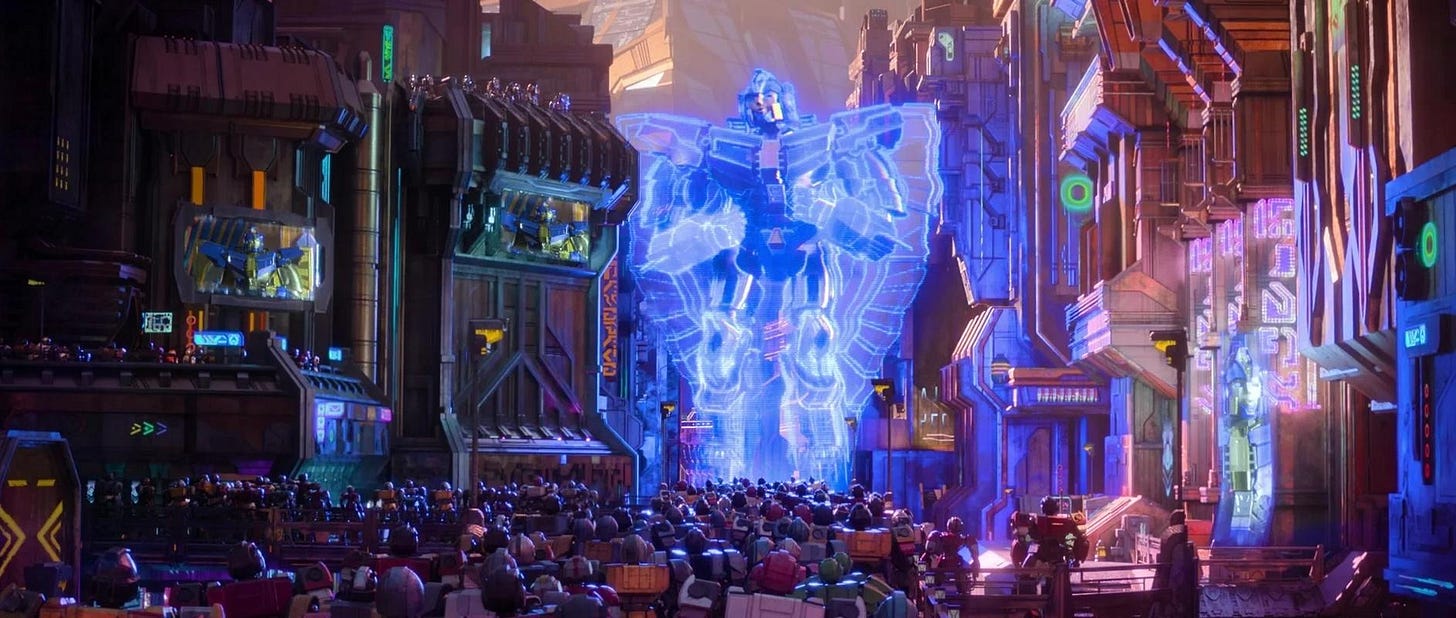
As much as the cogless miners despise their treatment by those functionaries, they revere Sentinel Prime; they dream that someday he will bring back the Matrix of Leadership, restore the flow of Energon, freeing them to choose their own destinies.
Ultimately, this is much like peasants in the Russian Empire who believed that abuses of power were isolated incidents, and that “if only the Tsar knew”, he would come and stop the oppression and make things right for everyone.
But the Tsar did know about the brutality and the oppression, because that was always his intent.
This is how Sentinel Prime behaves throughout the film; he allows his functionaries to perform the distasteful work, so that he can reap the benefits of a positive public image among the oppressed subjects of his regime.
In true bread-and-circuses fashion, Sentinel organizes a race, the Iacon 5000, to lift the spirits of the populace after returning home without the Matrix yet again.
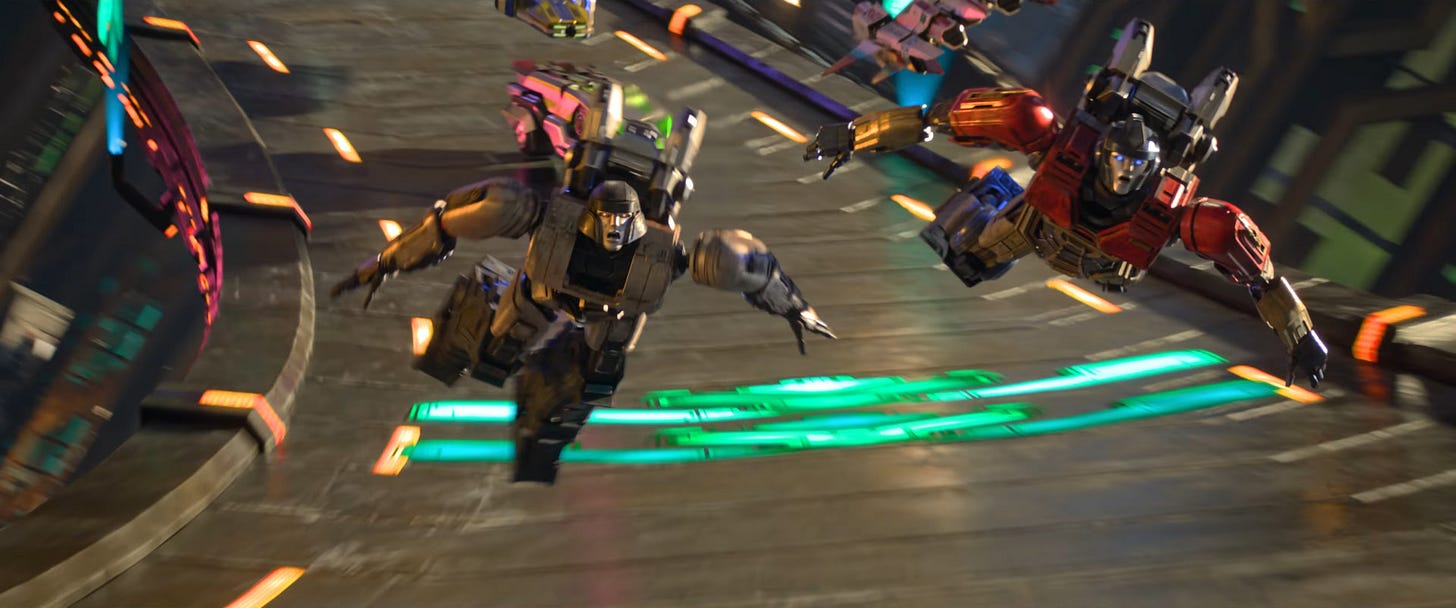
Despite not having the capacity to transform, Orion Pax sneaks both himself and D-16 into the race, against the latter’s protests. And while they do not win, the spectacle of their valiant attempt draws attention from both their fellow miners, and from Sentinel himself.
Orion Pax: "I'm sorry, D. But come on, didn't you feel it? Even for just a second, didn't you feel liberated? Didn't you feel like you were something else? Like you could be more than what they say you are?"
D-16: "Yeah, I felt it. I did. But it doesn't matter. We're going to get punished and demoted."
And yet the feared reprisal does not come; when Sentinel comes to them, he is impressed by their initiative. Yet it is clear to the audience, if not our naive pair of heroes, that Sentinel only has self-benefit in mind.
He sees that Orion Pax and D-16 have become inspirational to the other cogless miners, and that productivity rates have increased. His sole interest in the pair is that he can use them as motivational propaganda for the other slaves, to push Energon production even further.
But even this is a fate that the bourgeois class considers too good for their subjects. Darkwing (Isaac C. Singleton, Jr.), one of Sentinel Prime’s functionaries, is jealous that two cogless miners have gained the favour of his benefactor.
Rather than bring them to Sentinel’s facility as ordered, Darkwing throws them deep below the planet’s surface, and spreads lies that the two of them died as a result of injuries following the race.
It is unclear whether Sentinel knows their true fate, or whether he did intend what he said; what is important is that Sentinel’s pleasant words ultimately mean nothing in reality.
It is down in waste management where they meet B-127 (whom audiences will know in the future as Bumblebee), and find a message from the Primes indicating where they made their last stand. The three of them realize that this may be the secret hiding place of the Matrix, and begin their quest.
The trio, soon unwillingly joined by the demoted Elita-1, make their way on a waste management train to the true surface of Cybertron, above Iacon City. And here, they unravel Sentinel’s lies, and realize the horrific truth of their society.
Act Two: The Revelation

Here, they find the corpses of twelve of the Primes, slain in battle against the Quintessons. But one of the Primes, Alpha Trion (Laurence Fishburne), still lives. Now awakened from his fifty-year slumber, Alpha Trion reveals that Sentinel was never a Prime, and altered history to remove mention of them being the Thirteen Primes.
Merely their assistant, Sentinel betrayed the Thirteen Primes to the Quintessons, establishing a colonial puppet regime with an underclass of slaves. In exchange for the Quintessons sponsoring him, the supposed “waste management” shipments actually contain the Energon which the cogless miners slave away extracting.
Further, it is revealed that all Transformers are born with a transformation cog. The cogless miners do not have a birth defect; the cogs were ripped out of their chests by Sentinel at the moment of their birth, to create an underclass with a neutered capacity for revolution.
In essence? Sentinel’s Cybertron serves as a proxy for a colonial power, establishing an arbitrary class hierarchy based on pseudoscience to justify slavery and deliver large profits for his imperial sponsors.
The Matrix of Leadership is gone because Primus destroyed it, to ensure that Sentinel could not steal it from Zeta Prime’s corpse and use it against Cybertron’s people. Energon does not flow, because nature itself rebels against colonial extraction.
To say that our main characters take this poorly would be an understatement. Indeed, this is the part of the film where Orion Pax and D-16 are irreversibly set on their future paths.
D-16 has always seen himself as Orion Pax’s minder; while not complicit in the class hierarchy to the same extent as Elita-1, he attempts to fill the role of “model minority”. He believes that if he follows the rules and doesn’t make trouble, he will gain respect from the upper classes.
But at this moment, his entire worldview shatters, and he radicalizes rapidly:
Orion Pax: Sentinel Prime has been forcing us to work in the mines until our gears strip. And all the while he's been giving our Energon away to our greatest enemies!
D-16: Ugh, and what do you think he's going to do to us when he finds out that we know?
Orion Pax: I'm not thinking about what he's going to do! I'm thinking about what we're going to do!
D-16: Well, that's the whole thing! You're never thinking about anything else, just yourself! Fantastic! Another "Orion Pax Master Plan", I can't wait to hear this!
Orion Pax: Wait, don't you want to stop him?
D-16: NO, I WANT TO KILL HIM! I want to put Sentinel in chains, and march him through the mines, so everyone can see him for the FALSE PRIME THAT HE IS! I want him to suffer, and then to die, in darkness! But we all know that it doesn't matter what I want, right Pax?
Following this, Alpha Trion gives his own speech, to rouse the heroes from their depression, and remind them that truth and common cause bring them power. And at this moment, you see exactly who inspires Orion Pax to eventually become Optimus Prime.
Alpha Trion: What defines a Transformer is not the cog in his chest, but the Spark that resides in their core. A Spark that gives you the will to make your world better. My fellow Primes had that spark, and I see their strength in you. Take their cogs, and access your full potential.
Prima, Onyx, Alchemist, Micronus…
Warriors of noble spirit. Loyalty, Strength. Their uniqueness enhanced, by these…
They were one, you are one, ALL ARE ONE.
Orion Pax: You…you gave us…
Alpha Trion: The ability to change your world. How you use that power, is up to you.
Alpha Trion can see that D-16 is headed down an incredibly dark path, of retribution and violence. But Alpha Trion also believes in his principles, that freedom and autonomy are the right of all sentient beings.
So even though Alpha Trion may be fearful of what choices D-16 makes with the cog that he has been granted…he knows those are D-16’s choices to make. Alpha Trion knows that if he denies that autonomy, if he decides which people are worthy of being considered people, then he will be nothing more than Sentinel is.
The granting of the ability to transform to the four main characters should not solely be taken at face value. It is a metaphor for the empowerment felt by casting off the shackles of colonial upbringing, and rediscovering your history and your heritage.
These four now have the ability to change their world, because for the first time in their lives they know who they truly are.

Escaping a surprise assault by Sentinel’s forces on Alpha Trion’s hiding place, the quartet start to learn how to transform their bodies. While they continue their quest back to Iacon City with their proof of Sentinel’s deception, Alpha Trion is captured by Sentinel, and violently executed.
But as Orion Pax and D-16 talk, the latter is skeptical that truth is enough to unravel propaganda:
Orion Pax: With Alpha’s proof in that device, we will show everyone the truth.
D-16: You honestly believe it’ll be that easy? Iacon doesn’t want to hear the truth. They worship Sentinel. There’s gotta be a better way to bring him down.
Orion Pax: We just have to trust that everyone will believe what we show them!
D-16: I trusted Sentinel! With everything. I will never trust a so-called “leader”, ever again.
The distinction between philosophies is becoming very clear here. Both Orion Pax and D-16 seek revolution, but the revolutions they envision are radically different. Orion Pax seeks good leadership, but D-16 seeks no leadership. One seeks a stable and just society, while the other is now distrustful of the very concept of society.
At this point, all four main characters are captured, not by Sentinel’s forces, but by the remnant of the Cybertronian High Guard, the Thirteen Primes’ military forces.
Forced to abandon Iacon after Sentinel’s betrayal, they have since been reduced to terrorism, performing attacks on the Energon trains to both stop the flow to the Quintessons and to obtain Energon to supply their own guerrilla forces.
Immediately, Orion Pax and B-127 begin to fawn over the High Guard, recognizing their leader Starscream (Steve Buscemi) and lieutenants Shockwave (Jason Konopisos-Alvarez) and Soundwave (Jon Bailey).
But they soon realize that their idols have descended far below their former glory. Starscream declares that the idea of a unified Cybertron “is a myth”, and that the only thing that matters “is the strength of one bot over another.”
D-16, immediately disgusted by yet another “so-called” leader, takes up Starscream on his challenge. Brutally beating Starscream into the ground, D-16 gives Starscream his iconic scratchy voice by physically mutilating his throat.
Our three heroes watch in horror as D-16 threatens to shoot Starscream in the head, as Orion Pax begs him to stop. D-16 announces that this will be the last time he shows mercy, and the former High Guard all pledge their loyalty to him, as he promises them that they will stop hiding in the shadows, and will march on Iacon.
And indeed, at this moment, hiding stops being an option. Sentinel’s forces have discovered their hiding place, and in a surprise attack, D-16, B-127 and half the High Guard are captured and brought to Sentinel’s tower in Iacon City.
Orion Pax, Elita-1, and the other half of the High Guard remain, but their only proof of Sentinel’s Vichy-esque collaboration is destroyed. And at this point, Orion Pax reaches his lowest point, and fears his idealism is misplaced.
But Elita, finally showing her worth, tells Orion that his hopeful instincts push him to break the rules for a good reason. Elita, who has constantly denigrated him, and who has every reason to rub salt in the would, instead tells Orion that his “blind optimism” leads him to be “bold” and “courageous”, even if “extremely stupid.”
Elita-1: You’re inspiring. You can envision a better future that no one else can see.
It’s a nice personal touch in the film, to show that good leaders can be self-doubting, and need the support of friends who keep them honest, but also keep them moving forward. It’s also an interesting contrast to D-16, who is actively rejecting this emotional vulnerability.
From here, Orion Pax and Elita-1 recruit the remaining High Guard to launch an assault on Iacon City, to rescue their allies and overthrow Sentinel’s regime.
Here, the revolution begins.
Act Three: The Revolution

At the top of Sentinel’s tower, in his palatial estate, Sentinel gloats among his prisoners, and explicitly tells D-16 that he will distort history to pin his collaborative activities on them:
Sentinel: Oh, D-16. What a tragic story you'll be. Atop the leaderboard in your sector — and secretly a traitor.
D-16: I'm not a traitor. You're the traitor!
Sentinel: Nuh-uh. You, all of you, are traitors. You've been working with the Quintessons to sabotage my expeditions. You're the reason why I haven't found the Matrix of Leadership yet!
B-127: None of that is true!
Sentinel: Oh, trust me, it'll be very true when I'm executing you in front of all of Iacon. Because down here, the truth is what I make it.
The Quintessons do not care what false history Sentinel makes, because their colonial regime has outsourced control to Sentinel as a puppet leader.
They have no care for Cybertron’s culture or history, and do not care if they continue to be vilified; their only concern is that Sentinel’s regime submits to their control and continues to supply the Energon they demand.
But D-16, handcuffed, refuses to kneel before Sentinel and die in such fashion. If he is to die, he will do so on his feet, not on his knees. Sentinel beats him to the ground, and mocks D-16 for the Megatronus Prime sticker on his shoulder that Orion Pax gifted him.
Sentinel then reveals that after he killed Megatronus, he stole the cog from his corpse to make himself more powerful. Enraged, D-16 bites back at Sentinel, and receives severe consequence:
D-16: He was greater than you'll ever be!
Sentinel: I don't know, I'm pretty great! But, I can understand why you'd want to wear his face over mine. Here. Let's make sure it doesn't come off.
Using a blowtorch, Sentinel proceeds to brand Megatronus Prime’s face into D-16’s chest. Consider, for a moment, that their “metal” is the equivalent of our skin. Sentinel carves a brand into D-16’s skin, yet he merely grunts, refusing to scream in pain.
The High Guard who bear witness see D-16’s defiance, and they are inspired, not by optimism, but by strength. His cult of personality grows, and his political faction begins to take form.
But at the same time, Orion Pax has gone to speak to the oppressed. He goes to the cogless miners, because he knows beyond military force, the support of labour is essential to the success of the revolution.

While Alpha Trion is dead, his Spark returned to Primus, his wisdom lives on in Orion Pax. Returning to the slave quarters where he and his fellow miners live, he reveals the truth, and in his speech you see him begin the cultural revival of Cybertron, sharing the religious teachings he received from Alpha Trion:
Orion Pax: I went to the surface and I learned the truth. My friends, we were all born with transformation cogs, and then Sentinel, he stole them from us! He took away our ability to make our own decisions! He stole our freedom! But now, I'm offering you your first real choice: you can work a 23rd shift and mine yourself to death, or fight back against Sentinel with me, right now!
Sideswipe: How are we supposed to do that?
Arcee: We can't fight. We don't have cogs.
Orion Pax: What defines a Transformer is not the cog in its chest, but the Spark that resides in their core. A Spark that gives you the will to make your world better. And that Spark... Sentinel can never take from us!
Jazz: There's not enough of us! We need an army!
Orion Pax: And we have one. Elita is bringing troops. We are not alone in this. If we want to be in control of our own destinies, we will have to fight for it! Now is the time for us to stand up! For ourselves! Stand up for this injustice! I promise you, this fight will be worth it! Follow me; nothing can stop us when we stand together! Together, as one!
On one hand, we see Orion Pax inspire the worker with talk of equality and freedom. On the other hand, we see D-16 inspire the soldier with talk of strength and defiance. Two differing ideologies, two brewing movements, and inevitable conflict.
To skip things forward, both the High Guard and the Miners launch the revolution, obtaining and revealing proof of Sentinel’s complicity with the Quintessons. And the bourgeois class, while still desirous of their privileges, are awakened by nationalist sentiment.
Even if they do not care for the Miners, the upper class still believe Cybertron should be for them, not for the Quintessons they have still been taught to hate. They do not necessarily care for either of Orion Pax or D-16’s ideologies, but they will not assist in Sentinel’s defence.
Finally, Sentinel is defeated, and D-16 marches upon him, attempting to publicly execute him. But Orion Pax wrestles him out of the way, as the battle for Iacon City has already decisively concluded.
D-16: What are you doing!?
Orion Pax: It's over, D. Everyone in Iacon knows the truth.
D-16: SO DO I! He took everything from us! I have to do this!
Orion Pax: No, you don't! Rebuilding Iacon cannot begin with an execution!
D-16: He deserves to die! Can't you see that!?
Orion Pax: We're better than this. Don't be like Sentinel.
D-16 beats Orion Pax to the ground, and attempts to resume his execution of Sentinel. But after D-16 fires the shot, Orion Pax jumps in the way, having his right arm and half his chest blown apart.
Despite all the evil which Sentinel has perpetuated, Orion Pax believes that it is Cybertron’s collective decision what should be done with him, and that a cold-blooded murder will damage D-16’s soul in an irreparable way.
So as Orion Pax is blown over the edge, and dangles like Mufasa over a chasm, D-16 holding him by his remaining arm, his fears are unfortunately proven right.
Orion Pax: Dee…no…
D-16: I’m done saving you.
D-16 drops Orion Pax into the chasm, as his lifeless body plummets deep into the core of Cybertron. Horrified, B-127 and Elita look onward as D-16 gleefully rips Sentinel in half, and reclaims Megatronus Prime’s cog from his corpse.
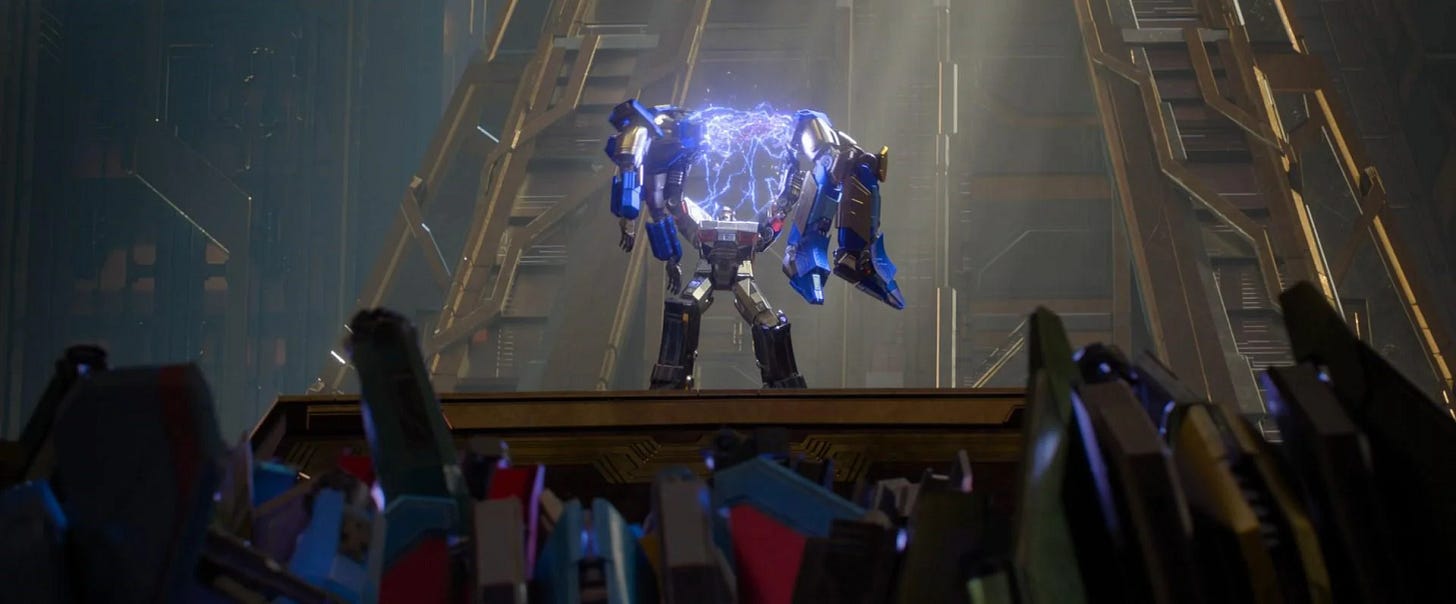
D-16 speaks to the crowd as the High Guard cheers in adulation, placing Megatronus Prime’s cog into his chest, and becoming one of fiction’s most iconic villains:
D-16: The Age of Primes has ended! No more false prophets! Follow me, and you will never again be deceived! RISE UP! I will lead us all into the future! I... AM... MEGATRON!
Rebelling against Cybertron’s heritage, rebelling against the very idea of divine anointment of prophets, Megatron takes the name of his former idol, but strips it of any affiliation with Primus.
Megatron and the High Guard begin to lay waste to Iacon, destroying everything Sentinel built while putting the people of the city in grave physical danger.
Starscream proclaims “All Hail MEGATRON!”, literally sticks his arm out at a 45-degree angle to remove any doubt as to the intended analogy, and in an instant, Cybertronian fascism is formed, with the desire to create a society where self-determination is only for those with superior strength.
But deep below the surface of Cybertron, in the core where Primus dwells and guards the Sparks of the deceased, the souls of the Thirteen Primes greet Orion Pax into their number.

At the core of Cybertron, the Spark of Alpha Trion speaks to the deceased Orion Pax:
Alpha Trion: Orion Pax, your noble sacrifice for the greater good has proven you worthy in the eyes of Primus. He entrusts in you the future of Cybertron, and...the Matrix of Leadership! ARISE...Optimus Prime.
With his sacrifice and descent into the afterlife, Orion Pax becomes a martyr for the people of Cybertron. While he is reborn and rebuilt as Optimus Prime, and given the Matrix of Leadership to show that Primus has found him worthy, the old version of himself is dead, and his fellow miners will never treat him the same way.
And that is because he is no longer merely a humble miner; he is the last of the Primes. He not merely a political leader, but now also a spiritual one. He is a prophet, who speaks with divine mandate, who has resurrected from death itself bearing the wisdom of gods.
At the same time, he has originated Cybertronian socialism. He is now the divine incarnation of the belief that the class divide on Cybertron must be abolished. He rises back to the surface to stop Megatron, and proceeds to banish him and the High Guard from Iacon City.
Optimus Prime: We were given the power to change our world, and you chose to destroy it, just like Sentinel. You have betrayed Cybertron and its citizens...and you betrayed...me. Go. Take the High Guard, and leave. You are...banished from Iacon. It didn't have to end this way.
Megatron: This isn't over... Prime.
The revolution has concluded, at great personal cost. As Starscream proclaimed, a unified Cybertron is indeed a myth. While Optimus and the people of Iacon remain to rebuild, Megatron and the High Guard are forced to return to the surface, and resume their life as scavengers.
Both Optimus and Megatron believe that the other now resembles Sentinel too much for comfort. And in a fashion, both are correct. Optimus is fearful of Megatron’s fascist ideology, and Megatron is enraged at the perpetuation of religious authority.
Coda: The Revolution Never Ends

The film ends with a moment of triumph, only to be followed by a post-credits stinger that rips it away and replaces it with dread of coming horror.
Bearing the Matrix of Leadership, Optimus Prime restores the flow of Energon to Cybertron. Both in Iacon City and on the surface above, life begins to flourish once more as the environmental exploitation of the colonial puppet regime is reversed.
At the same time, new cogs begin to flow out of the core of Cybertron, entering the chests of every cogless miner, and erasing the class divide on Cybertron. No longer is Cybertron split between those who transform and those who do not, and no longer is it split between those who consume Energon and those who mine it.
Optimus Prime: And now we stand here together as one, proving we all have the power to transform. To become who we were destined to be; to right wrongs, to make our world better.
Because here, freedom and autonomy are the rights of all sentient beings. Here, all are truly Autobots. This message is a warning to all Quintessons: If you dare return to Cybertron, the Autobots will be waiting. I will be waiting. I... am Optimus Prime.
Again, a triumphant moment. Optimus Prime erases the division of class, and creates a socialist utopia in Iacon City. But then the post-credit scene rolls, and you realize this utopia will not even last a day.

The truth is that after the overthrow of a colonial regime, things are messy. Rival ideologies seek to fill the power vacuum, and colonial powers will seek to reassert their control by sponsoring new proxies.
And Megatron makes it clear with his speech, to a crowd of followers snapping their arms in salute and branding themselves with his sigil:
Megatron: Sentinel, the betrayer, is dead. But his death has given life to a new enemy...a stronger enemy...a personal enemy. We will not be blinded by his deception! We are the ones who are...Decepticons! RISE UP!"
The parallels of a fascist group taking a religious symbol and appropriating it as their own are not lost on me. And indeed, from every other piece of Transformers media to ever release, we know what follows.
Cybertron is destroyed by a brutal civil war for control between the Autobots and Decepticons. Cybertron’s people become galactic refugees, a diaspora population spread thinly throughout the stars.
The oppressor is thrown off, only for new oppressors to appear. The war spreads beyond their dead planet, until even the origin of these ideologies is forgotten. And the revolution?
The revolution never ends.
Why didn’t the movie make more money?
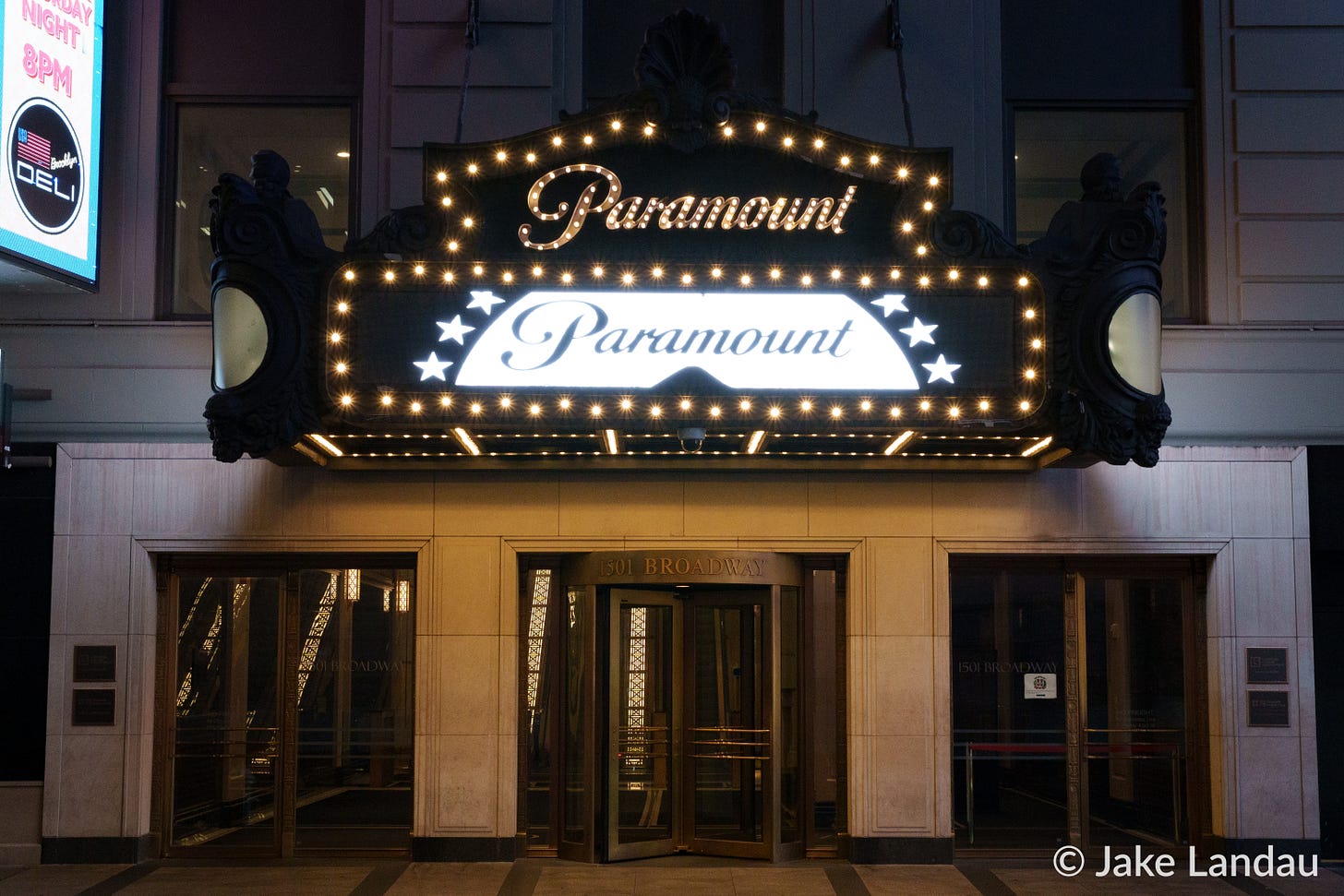
I really liked this film, enough to write roughly ~6700 words about it for a Deep Dive column.
I hate the fact that Transformers One didn’t perform well at the box office, and that following the release of the film, Hasbro announced it would no longer co-finance films based on its IP due to the fiscal risk, leaving financing of film adaptations solely to the licensing studio.
But I also can’t particularly blame Hasbro for that, nor for having a thin lineup of tie-in toys when the film wasn’t promoted in a way to create the demand for those toys. Paramount marketed this film terribly.
Rather than focus on the mature tone of the film or the nuanced plot and themes, marketing instead highlighted the one comedic relief character. Brian Welk of IndieWire described his impression from the film’s first trailer as follows:
It has madcap comedy and action that’s geared toward a younger audience but should also appeal to diehard Transformers fans.
The live-action Transformers movies already hung an albatross around the neck of this film; the mass public now associates Transformers with Michael Bay’s senseless action and explosions, and the marketing didn’t do much to dispel the illusion of this being more explosions for a younger audience.
As a result, the public really can’t be blamed for brand skepticism; at the beginning of this piece, I indeed recount my own skepticism. But it’s incredibly frustrating that because of poor marketing, audiences didn’t see reviews like this from Todd Gilchrist at Variety:
…while still delivering the fun and excitement expected of Hasbro’s metamorphosizing robots, “Transformers One” approaches the well-known characters with a degree of nuance and complexity (as well as violent finality, in a few cases) that marks the most sophisticated onscreen portrait of them to date.
"The most sophisticated onscreen portrayal to date” is a bold claim, and yet from the word-of-mouth I received, and my own opinion, it’s clearly not a unique sentiment. This is a very meaty film, with a great deal of political themes that can be unpacked over several viewings.
The final nail in the coffin for Transformers One was the release of another animated film from DreamWorks, The Wild Robot, which itself has received critical acclaim and contended for an Academy Award last month.
Wild Robot was much more popular with family audiences, despite being based on an intellectual property with less public exposure, and ended up stealing away the lucrative premium screen formats like Cineplex’s UltraAVX that charge higher ticket prices and thus bring larger returns.
Transformers One has developed a cult following, with a vocal fan base online that communicates regularly with the creative team behind the film. While a sequel would be greatly appreciated, it’s also unfortunately unlikely at this stage; it is unclear whether Paramount will make a new Transformers film before their license to Hasbro’s IP expires.
So I’ve tried to do my part here. I went to see the movie in theatres several times, I’ve watched it on home video several more times, and through word of mouth, I’m attempting to show people how compelling the narrative of the film is, and how an adult audience can find a lot to appreciate in the nuanced themes.
But of course, there’s one more thing. From Hasbro’s perspective, these narrative adaptations of their property do ultimately serve one core purpose, and that is selling plastic. Hasbro will prioritize certain adaptations of the brand over others based on what drives the sales of products.
So despite not having done so in over twenty years, I did something I wasn’t expecting to, because I really, really liked the film.
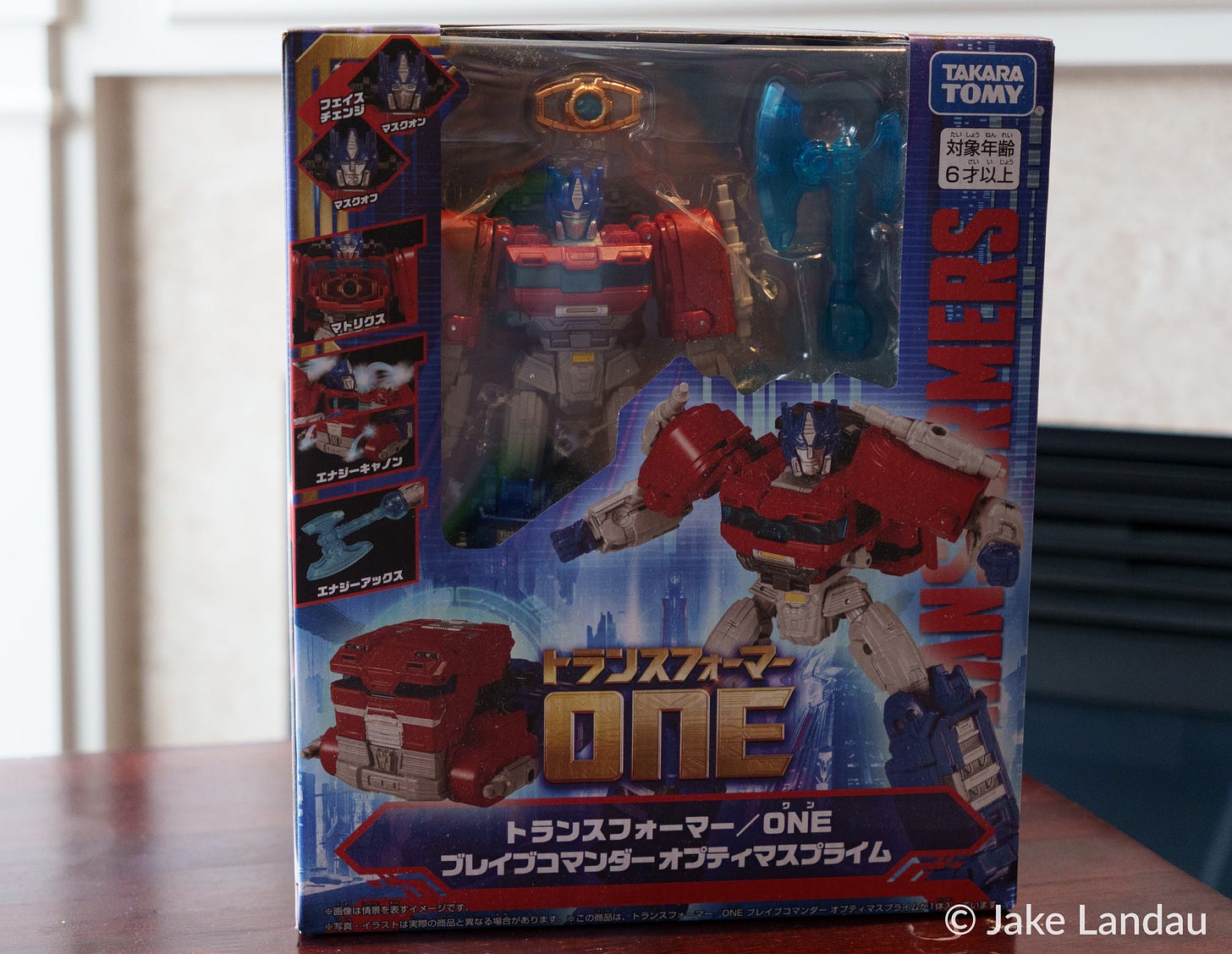
From The Land of the Rising Sun, I bought not just any toy, but the flagship toy. The best toy. Of all the Transformers One toys, this is the toy. Brave Commander Optimus Prime, manufactured by Hasbro’s equal partner in Transformers, Japanese brand TakaraTomy.
And if nothing else, putting aside the talk of politics and revolution?
I like the toy. It’s a nice toy. Go buy the toy!

